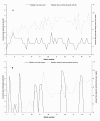The relationship between low back pain and leisure time physical activity in a working population of cleaners--a study with weekly follow-ups for 1 year
- PMID: 22356733
- PMCID: PMC3306730
- DOI: 10.1186/1471-2474-13-28
The relationship between low back pain and leisure time physical activity in a working population of cleaners--a study with weekly follow-ups for 1 year
Abstract
Background: Low back pain (LBP) and leisure time physical activity (LTPA) are considered to be closely related, and clinical guidelines for the treatment of acute LBP recommend patients stay physically active. However, the documentation for this recommendation is sparse and based on studies involving patient populations. The purpose of the study was (1) to investigate the correlation between LBP and LTPA on a weekly basis over the course of a year in a high-risk group of cleaners; and (2) to investigate if maintaining LTPA during an episode of acute LBP has a positive effect on LBP intensity in the subsequent 4 weeks.
Methods: 188 cleaners consented to participate in a 52-week text message survey about hours of LTPA and intensity of LBP (from 0 to 9) over the previous 7 days. The correlation between LBP and LTPA was calculated by Pearson correlation coefficient. During an episode of acute LBP, a mixed effect logistic regression model was used to investigate whether cleaners who maintain LTPA have a lower pain intensity and higher probability of returning to initial pain intensity within the following four weeks compared with cleaners who decrease LTPA during acute LBP.
Results: The correlation between weekly LTPA and LBP data was negative, but numerically low (r = -0.069) and statistically insignificant (p = 0.08). Among the 82 cleaners experiencing at least one episode of acute LBP, those maintaining LTPA during an episode of acute LBP did not have a lower pain intensity (average LBP intensity difference between groups of 0.06; 95% confidence interval (95% CI) of -0.417 to 0.539) or higher probability of returning to initial pain level (Odds ratio 1,02; 95% CI of 0.50 to 2.09) in the following four weeks compared with cleaners decreasing LTPA during acute LBP.
Conclusions: Hours of LTPA and intensity of LBP measured on a weekly basis throughout a year showed no close correlation. Maintaining LTPA during an episode of acute LBP did not result in a positive effect on LBP in the following 4 weeks. Documentation of LTPA recommendations for acute LBP in working populations is still needed.
Figures





References
-
- Unge J, Ohlsson K, Nordander C, Hansson GA, Skerfving S, Balogh I. Differences in physical workload, psychosocial factors and musculoskeletal disorders between two groups of female hospital cleaners with two diverse organizational models. Int Arch Occup Environ Health. 2007;81:209–220. doi: 10.1007/s00420-007-0208-x. - DOI - PubMed
-
- Woods V, Buckle P. Musculoskeletal ill health amongst cleaners and recommendations for work organisational change. Int J Ind Ergonomics. 2006;36:61–72. doi: 10.1016/j.ergon.2005.08.001. - DOI
-
- European Agency for Safety and Health at Work. The Occupational Safety and Health of Cleaning Workers. Bilbao. 2019.
Publication types
MeSH terms
Associated data
LinkOut - more resources
Full Text Sources
Medical
Miscellaneous

